June 13, 2019 - 2:07pm

My Alan Scott oven project begins
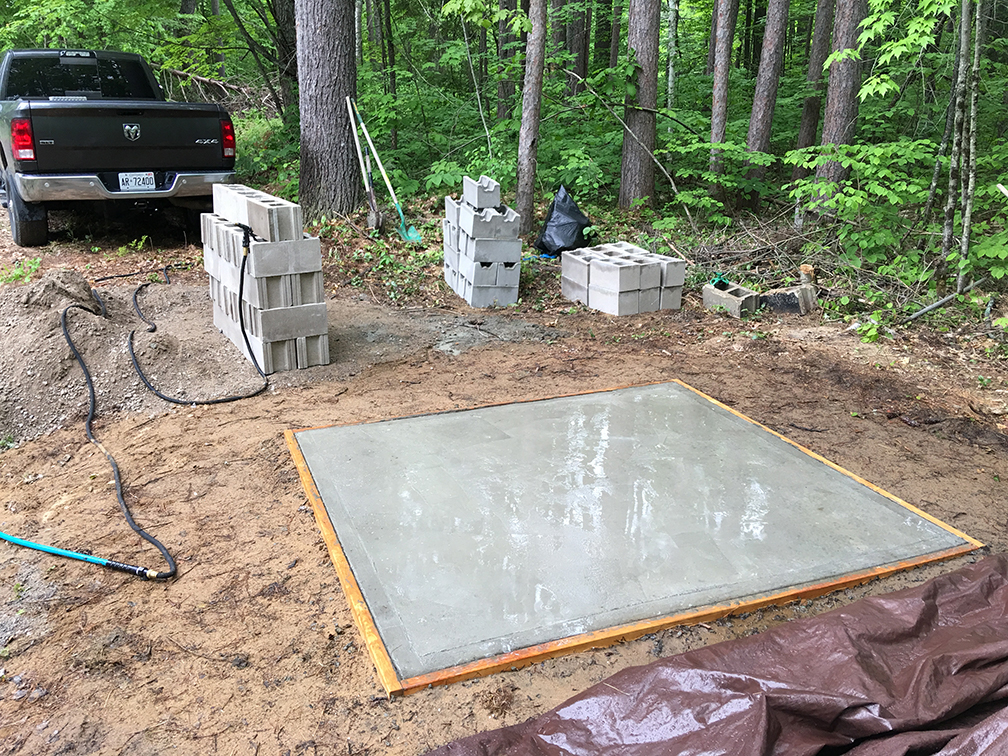
Hello everyone,
After trying without success for two years to get the plans for an Alan Scott oven, I have begun to build without them. I am using "The Bread Builders" as my guide, and will be building the 36x32 inch size. Here are a few pics. I will likely start the block walls on the weekend. I am currently waiting for the concrete slab to cure.
Dean


Good luck with your build Dean and keep us posted on your construction. Having built a pizza WFO myself, I love a good build thread!
Lance
Thanks Lance! It is exciting to get started, and to see a dream starting to take shape.
And I'd like to post more pics, but can't seem to attach any to my posts. I click the "insert image" icon, then select them from my hard drive, but nothing happens. And they are under 1 MB, so I don't know why I can't upload them. Anyway, I'll post more pics if I figure out how. :)
Dean
Great project. Make sure to take progress photos throughout the build. I built a Pompeii style (dome shape) in 2005 and have used it frequently and always with friends and family to enjoy the spoils. They are much more than pizza ovens and once you learn how to set-up the various cooking environments, "the worlds your oyster"; pizza, roasting, baking, grilling and bread. Also, mine was exposed to the weather so I built a shelter over the oven to keep it dry and also the cook!
Cheers,
Gavin.
Dean,
If you haven't got the full plans for a vaulted oven, some detailed advice might be useful. There's an Aussie with a user name downunderdave who posts on http://ukwoodfiredovenforum.proboards.com He may be on Fornobravo too.
He has a great knowledge concerning that style of oven, so it might be worth getting in touch.
Lance
I commend your thoughtful location, right next to your fuel supply.
Gavin I can't wait to explore all the cooking/baking/grilling possibilities! And I am a bit of a photography freak, so I will document it well. Though I still can't seem to upload any images for some reason.
And Lance, thanks for that link. I will check out downunderdave. Justanoldguy, I will likely do my first burn with the trees I had to cut to make room for the oven. But yes I will never have to walk far for firewood. I also have a cousin with a portable sawmill a few miles away that produces endless slabs. What in the world do people that live in the desert do for wood if they want an oven like this? Feeling very lucky...
Dean
Hello all,


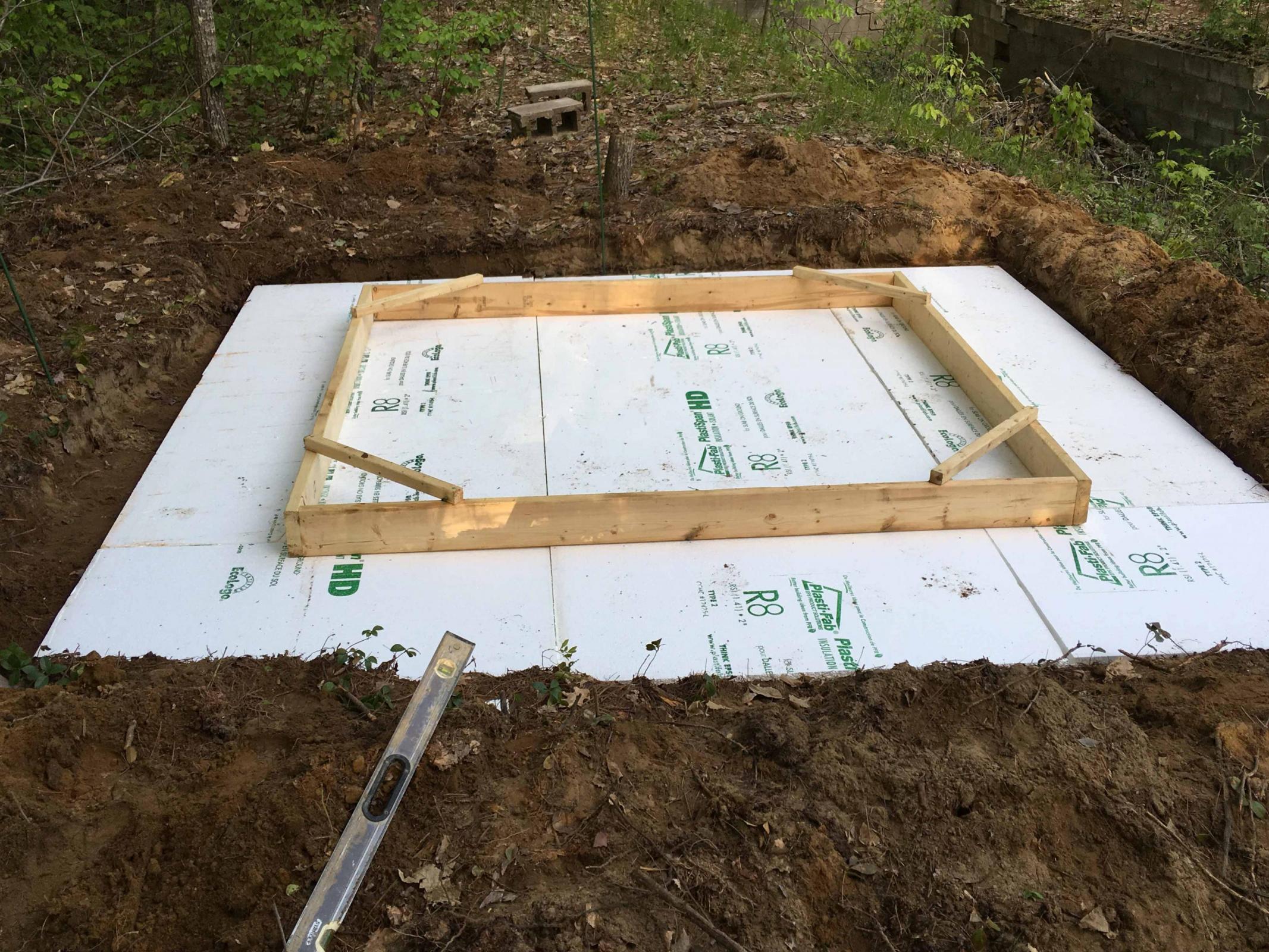

Here are a few pics. The first pic is how far I got today, and the other three pics are from the earlier part of the build. My nephew and niece helped with the pour of the foundation slab. The pics got shuffled somehow uploading, so they are out of order. Is there a way to reorder them that anyone knows?
I am very slow laying the blocks, as I have never done it before. But it is going well, and I hope to finish the 4th and last round tomorrow. I learned a painful lesson about handling blocks all day with bare hands, and touching mortar with bare hands. My fingertips got sandpapered, and then the mortar made them burn terribly yesterday. Yes I knew I should not be touching the mortar. But my rookie inability to butter the ends of the blocks before laying them ensured a lot of mortar had to be stuffed into joints by hand. Today I put on a pair of latex disposable gloves, then covered them with cheap cotton gloves. That worked great, and seems to be a good solution.
Dean
Here are some new pics from the last few days. I just got a price on fire bricks and Heat Stop 50 for the hearth pour. I will be using alumina cement for the hearth and cladding, as I would like the option for someone in the future to be able to fire the oven every day. Portland cement apparently loses too much strength under those conditions, and with a suspended hearth slab, I don't want to have to worry about the possibility of it sagging. I intend to leave the plywood form supporting the hearth from underneath until I really need to remove it - at least a few months. I will let the concrete continue to gain strength before subjecting it to gravity. I am also considering adding one inch to the thickness of the hearth slab. And since the plans are with imperial blocks, and I am using metric, my inside wall dimensions ended up about 1 inch longer and wider than they should have according to the plans. Of course I discovered this after I have already made the form for the hearth slab. :) So I made it again to the new correct size. So long story short, my hearth is going to be heavier than usual for these plans, and as such alumina cement seems the logical choice. I will drive to Ottawa to get the firebricks and cement in a few days.
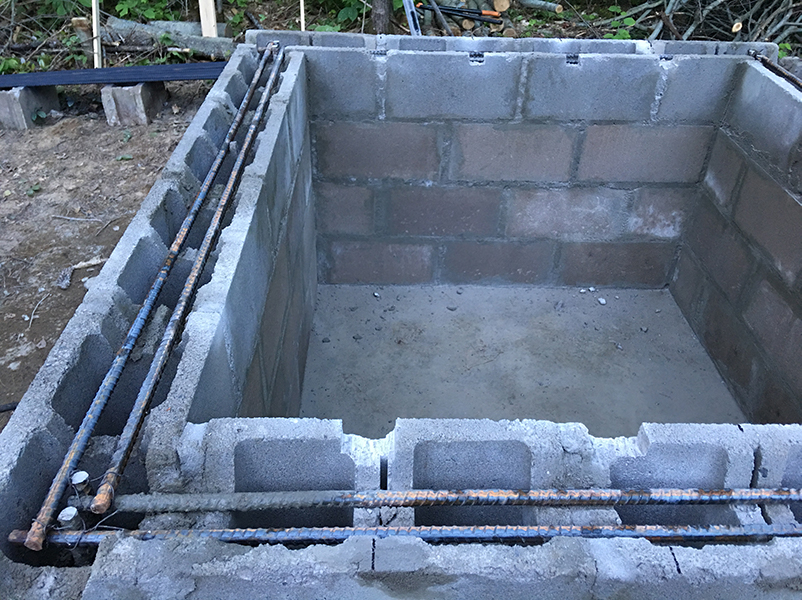

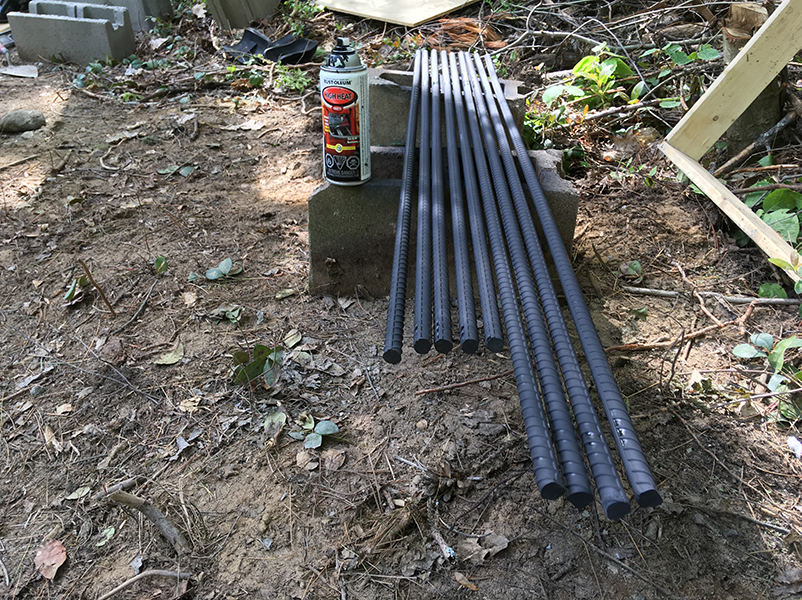

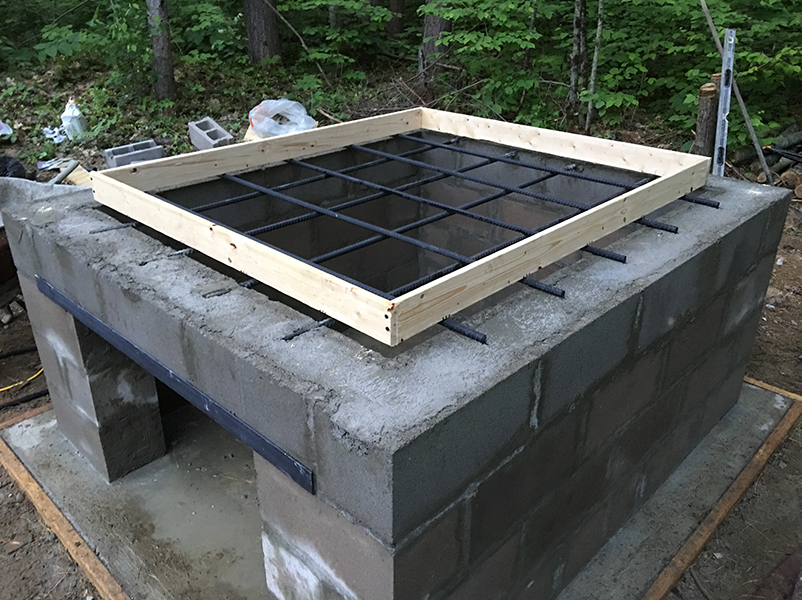
Dean
Are you installing an insulation layer under the hearth or will the alumina cement provide that? Looks great so far.
Yes, you need at least 50mm of calcium silicate insulation board or similar under your hearth; and 50+ mm of ceramic fibre blanket on top, unless you are doing a loose fill vermiculite pour with roof.
But maybe you've got all that planned - with a structural "hearth" then calsil board, then firebrick?
Lance
Hi guys,
Under the hearth firbricks will be about 4 inches of alumina concrete, then about 6 inches of perlite concrete for insulation. I did consider ceramic board type insulation for under the hearth slab, but it is expensive, and I have lots of room for perlite concrete. If 6 inches of it is not enough, I can always add a ceramic board later. And above the oven dome will be 4 to 5 inches of alumina concrete, then more perlite concrete for insulation.
Dean
Is the perlcrete layer above the alumina layer and below the firebrick?
Albacore, from top down it will be firebricks, alumina concrete for thermal mass, then perlite concrete for insulation.
Dean
I'm not familiar with the plans, but it looks like you will have 6.5"-7" of thermal mass in the floor, if the firebricks are flat. That should be good for bread baking with retained heat, but may need a prolonged heat up time.
Lance
Hi Lance,
The fire bricks will be on their side, so I will have about 8 inches of thermal mass, then 6 inches of perlite concrete for insulation. I have unlimited free firewood steps away from the oven, so heat up time is not an issue at all. It can take all day if it wants, then cook my dinner a few days later. :)
Dean
Hi everyone,
I will be starting the firebricks within a week, and I am wondering about joint thickness. I am using Heat Stop 50, and they recommend a 1/16 to 1/8 inch joint. My plans call for 1/4 in. In the attached pic (not my oven) you can see the joints in question. The dome will be built striving for zero mortar exposed on the inside edge of the bricks. The website for Heat Stop 50 also says that joints up to 1/2 in are common and acceptable, so the advice even from the manufacturer is not exactly clear. I am building this oven hoping it will last at least 100 years, and do not want to make any durability sacrifices if they can be avoided.
So my question is, is there any reason why I cannot use a smaller joint that the plans call for when I mortar the bricks in the attached pic into place? Can I just add a brick or two to make up the difference that the thinner joints will make? This will also save me a lot of very expensive Heat Stop 50. At $150 Canadian for a 50 lb bag, this would be a nice bonus.
Dean
Hi everyone,
Here are some updated pics of the oven build. I am pretty much ready to pour the hearth slab on Sunday. I will be pouring it 4.5 inches thick with a 3.5 inch deep form, so my rebar looks off center in the slab in the pics, but will be centered in the end. Under the 4.5 inches of alumina concrete will be 5.75 inches of vermiculite concrete for insulation.
I had some trouble finding pure igneous crushed rock, but finally got a lead on a quarry that had exactly what I wanted - crushed granite, free of any other types of rock. From 1/2 inch down to fine dust, and everything in between. You can see them blasting it out of bedrock behind the loader in one of the pics. Combined with Heat Stop 50 cement, it should make some incredibly hard and durable high temperature concrete for the hearth slab and the cladding. And with pure igneous rock I should have no worries about exploding/expanding rocks inside the concrete at some future date.
Dean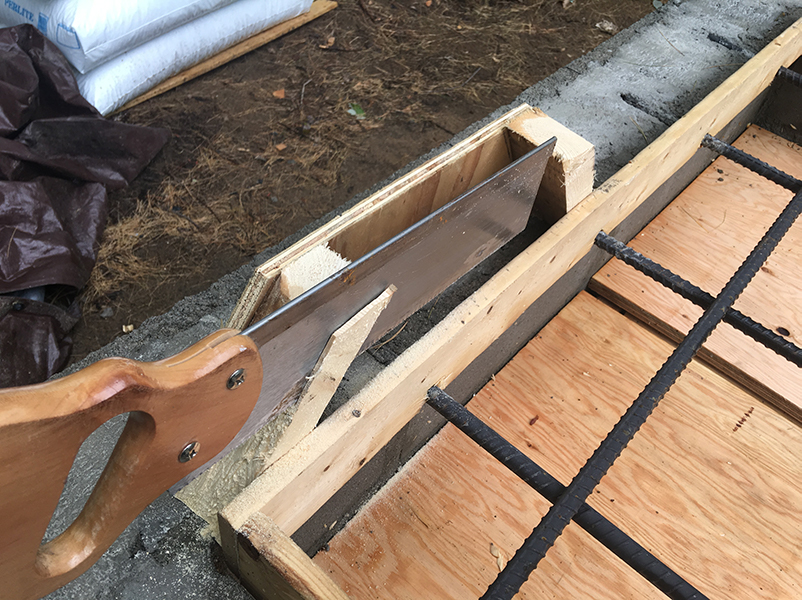


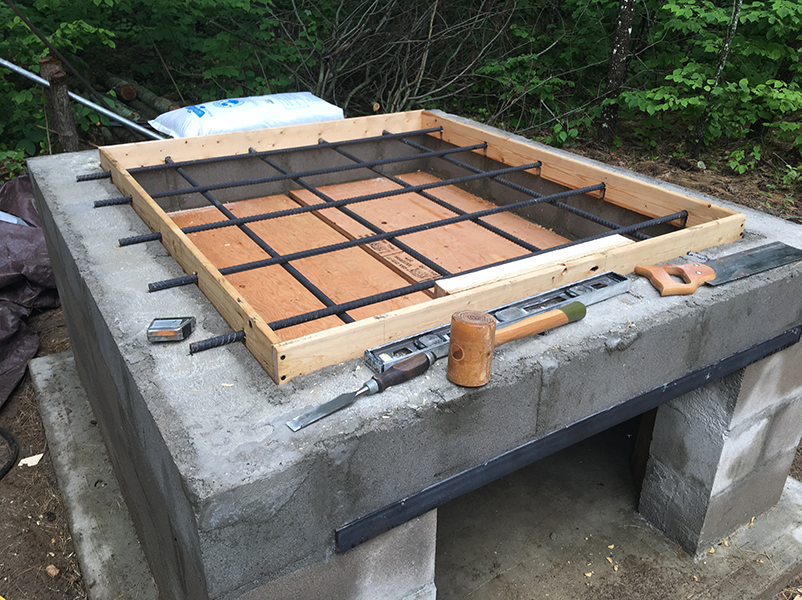



Hello everyone,
Here are some updated pics to the oven build. I will let the hearth slab wet cure a few more days, then start laying the hearth bricks in fireclay/sand.
Just before pouring the hearth slab, I found out that alumina cement actually loses MORE strength than Portland up to 500C, is about the same as Portland up to about 800C, then does better than Portland from that point on. So there seems to be no advantage to me to use it, so I didn't. I used only crushed granite as aggregate for the slab.
I poured 5 3/4 inches of Perlite concrete as insulation under the slab. Then I topped it with 4 1/2 inches of normal weight concrete.
Dean
Looking good so far. I'm enjoying following your build. I guess that is a dry run of the bricks. I did a dry run with my first layer of bricks to make sure had the door in the right location (a round dome build).
Hi gavin,
Yes this is a dry run. I am going to deviate from the plans that call for 1/4 inch joints. I am going to try to get them down to 1/16 inch by dipping the face of the brick being laid in a wet slurry of Heat Stop 50 instead of buttering them with a trowel. I called the manufacturer today and asked about it, and they said it should be fine. He said to do a test by seeing if I can tear apart two bricks using this method. And he emphasized that thinner joints are more durable. My cousin is a bricklayer by trade, and has built a few Pompeii style ovens using this "dipping the bricks" method and they are doing fine. As one who has never laid a brick in my life, I think that this is going to make this part of the job a lot easier than I thought. I plan to use a small oven meatloaf type of pan for dipping that is just a bit bigger than the bricks. This will let me mix an absolute minimum of the expensive Heat Stop 50 at a time. I'll keep you posted, as I hope to start brickwork within the week.
Dean
If I was closer to you I'd gladly come over to help with some of the labour. Melbourne (Australia) to Ontario is a bit more than a short drive :).
..and there is a pretty big puddle in the way too. :)
Hearth bricks are laid. I used a 50/50 fireclay/sand mix as a base. I should be able to start the walls tomorrow.
Dean
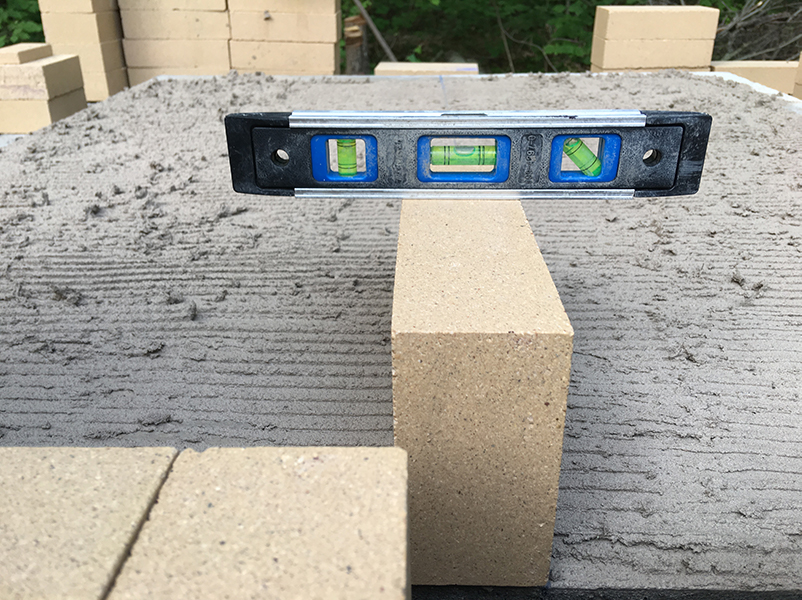

Hello all,
The walls are done, and I am making the template for the roof arches. I removed the hearth slab forms as well. Now you can see through the ash slot to the foundation slab below. I will start the roof tomorrow.
Dean
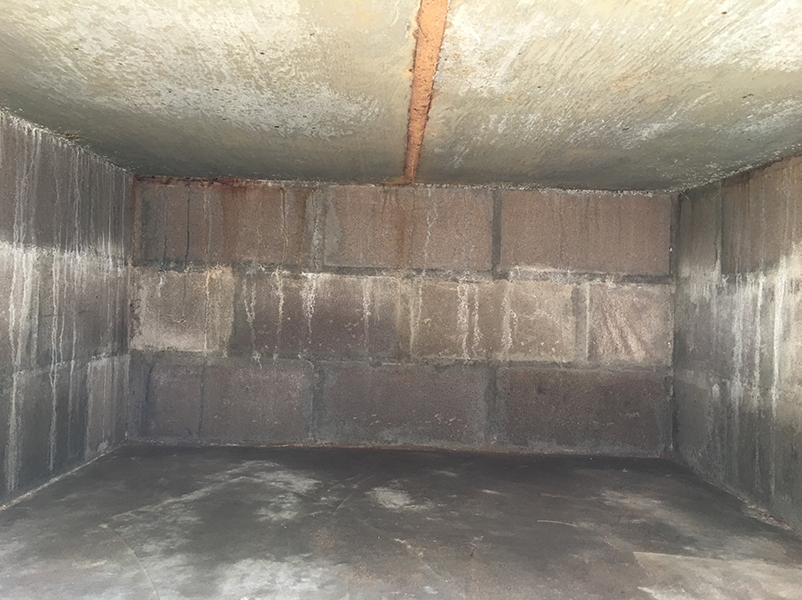


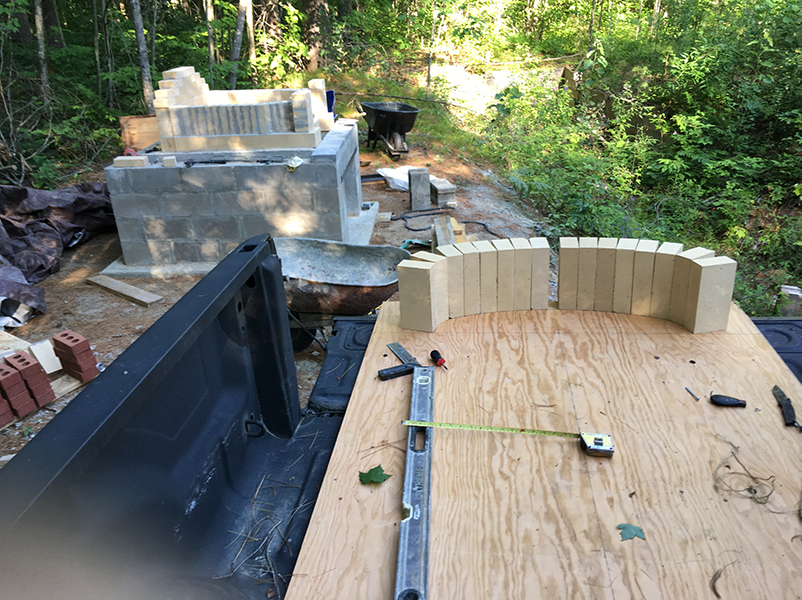
How's progress?
Hi Gavin,
Yeah I haven't posted much lately, but I have been busy. Here are some recent pics. Sorry for their random order. I can't seem to control how they upload.
Dean


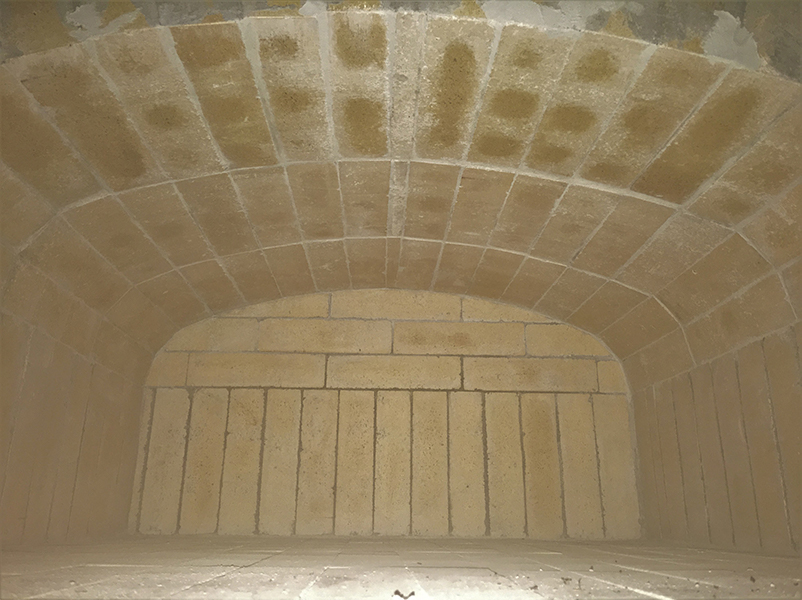

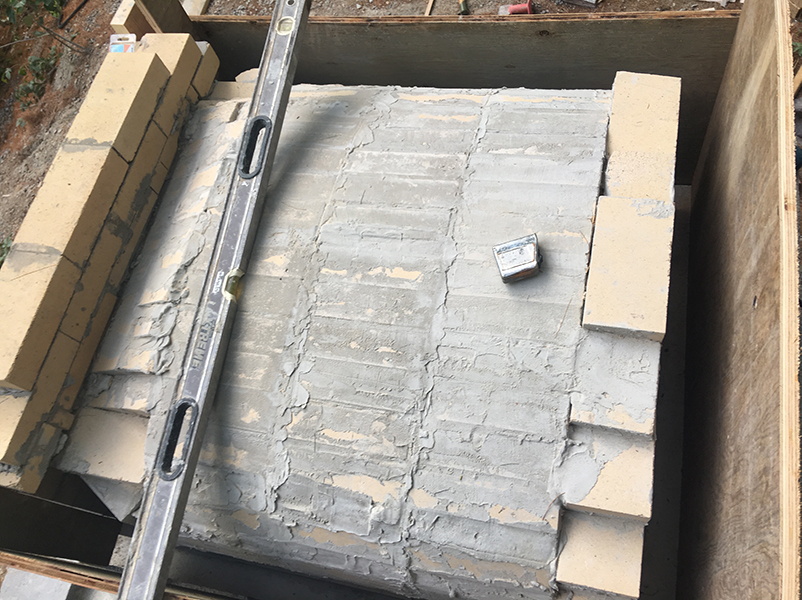

The granite slabs will make up the outer hearth and entrance tunnel. The big pink slab will be the center piece. I am almost ready to pour a few inches of concrete over the brickwork.
Dean
Looking great. I like the idea of the granite outer area.
Cheers.
looks great ! Dean
Hi everyone,
It's been a while since I posted new pics, but I have been busy on the build. Concrete cladding has been poured, and I have begun the granite hearth. The Flintstone slab spanning the pillars of the entryway that is visible in the second pic is being replaced with one that matches better. The last few pics are from today of me cutting it and notching it for the steel. This slab will have to hold its own weight, plus the weight of the front of the chimney which will rise directly above the angle iron. Granite is known to crack under high heat, so all the steel is there to make sure that won't be a structural issue if it does. I will be putting aluminum foil between the steel and the granite when I set it into the mortar. The steel and granite have different rates of expansion, and by letting the steel "float" I hope to stop it from cracking the granite as it expands and contracts. The colour of the granite when wet is stunning. Too bad it will never be wet after it is finished. :)
Dean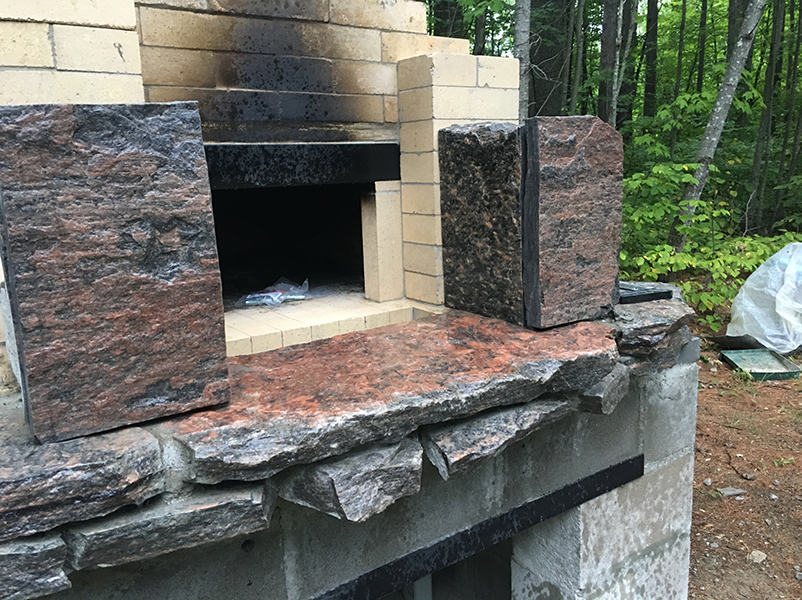
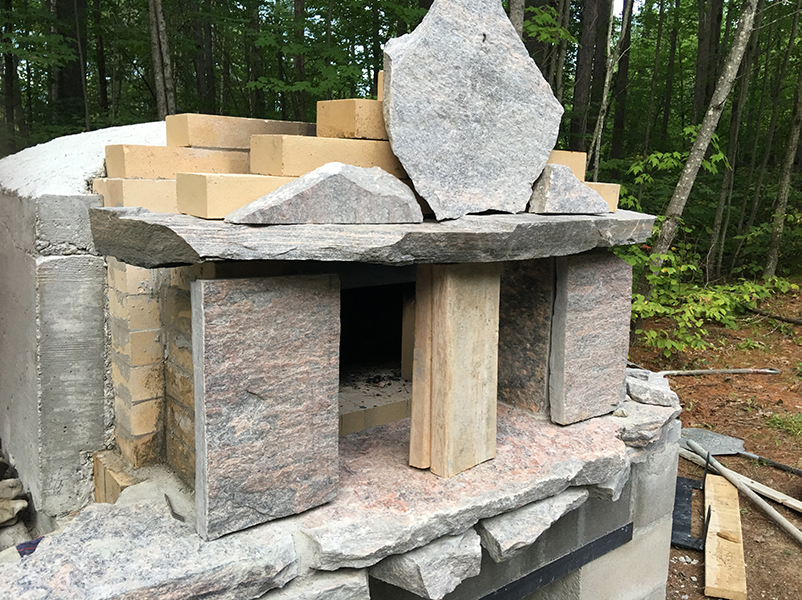



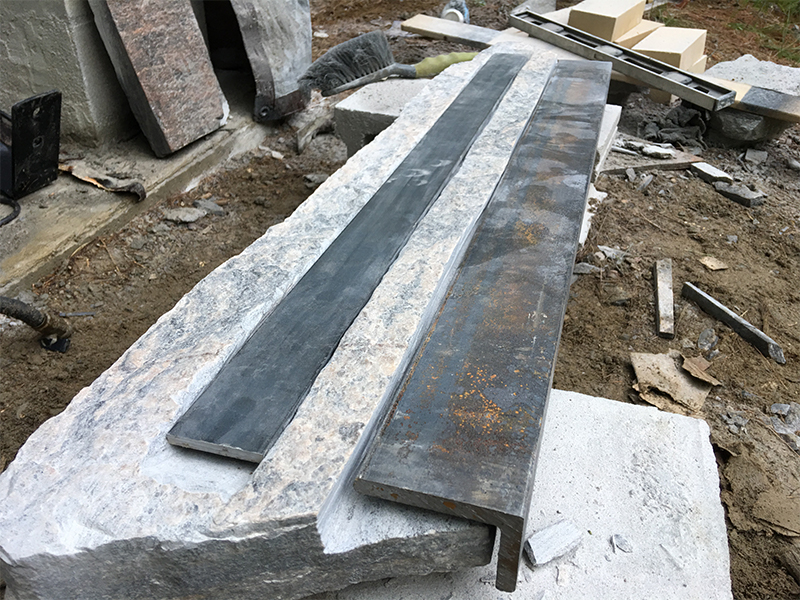
Hi everyone,
Here are some recent pics of the oven build. Drying fires are mostly finished and I will be burning it clean next burn when the rain stops.

Dean
Looking great. I bet you are feeling a great sense of accomplishment.
Cheers
Gavin
Hi Gavin,
Well I only had time for a few batches of bread before the weather chased me south for the winter. I am an astrophotographer, and spend the winters out in the middle of nowhere in the desert in my RV, as far from town lights as possible. I am currently in California near the border with Arizona. There is petrified wood everywhere, and it is legal to take 250 lbs a year from BLM land. Here is what I found within 100 feet of the RV in about 10 minutes. I will use some of the flat pieces to face the chimney when I get home in the spring.
Dean
Hi Dean,
Great find. Do you have to cut and shape the petrified wood at all? It looks very interesting. We are in summer here. Our bushfire season has started early, so it looks like a long hot summer. The air is very smokey and people have been warned to stay indoors or wear breathing masks. Hopefully, we will get some rain tonight and over the next few days to dampen things down. There has been a very big loss of property and several people killed. Very sad, but we are safe and live close to the water if needed. Obviously there is no lighting of hard fuel BBQs or brick ovens for awhile.
Cheers,
Gavin
Hi Gavin,
The petrified wood is likely going to be set into mortar like field stone. I will cut it as needed. I picked up a lot more nice flat pieces today and will probably face the whole chimney with them.
All eyes are on Australia here in Canada and elsewhere in the world. Unbelievably bad situation, and I sure hope it rains for you soon.
Dean
Getting around the strings of satellites going up each week?
First time I saw them, I felt like I was in a sci-fi flick.
The oven looks so beautiful. Can you get a wet granite look by rubbing the stone surface with a thin layer of mineral oil or better yet, Vaseline. The latter being used because it is neutral and mineral based. You can test a scrap piece.
Hi mini,
The clouds or wind have been constant for the dark periods of the month when the moon is gone for the last three months. I haven't had enough exposure time this winter to have seen any of Musk's satellites yet. I am very apprehensive though. I have a lot of money and time and energy tied up in astrophotography, and I sure hopes he finds some nice black paint before putting up many more. Here's a link to my gallery if you are interested.
https://www.astrobin.com/users/headdown/
Thanks for the kind words about the oven. I did wonder about some kind of oil to bring out the colors of the granite, but I think the heat would just cook it off in no time at all. The hearth does get very hot eventually when the fire is burning. I will probably give it a try at some point. Even some kind of sealant might work, but it would have to be heat resistant.
Dean
Hi everyone,

It's been a while since I updated, and I will post more pics soon. I hope to have the brown metal roof panels on within the week. The insulation is complete up to the height of the walls, and 2 thermocouples have been installed in the concrete cladding over the vault. One is 6 inches from the flames, and one is 9 inches. The one 9 inches from the flame is almost to the insulation layer. It has been fascinating to see how the heat moves through the masonry mass. I will write in more detail about that topic soon. Early testing with all the insulation piled on shows a loss of just 40F every 24 hours. And while as expected it takes a long time to get the entire thermal mass up to high temperature, for just one load of bread or bagels that is not necessary. It takes about 3 hours to burn clean from cold, and I leave the coals in for another half hour to an hour so as not to waste the potential heat. Incredibly, even though the oven interior is so hot that it has burned clean, the closest thermocouple to the fire has hardly moved yet! So once it has burned clean and the coals have been removed, I put the door on for an hour or so for it to equalize. During this time, the heat is slowly seeping into the outer masonry. Within a few hours, the interior of the oven will have dropped to the range needed for a load of bread, and will slowly drop as the bread is baking. That is fine. That heat has not been lost...it has been stored for later use. I will write more later about what it takes to totally heat the entire mass up to high temperatures. But for now, I would say it appears to be a myth that ovens with a lot of thermal mass take much longer to heat up to baking temperature than ovens with less thermal mass. Of course it will take longer to saturate the entire thermal mass if the oven is heavier, but that is not relevant if you just want to bake one batch of bread, or make pizza.
Dean
Hello all,
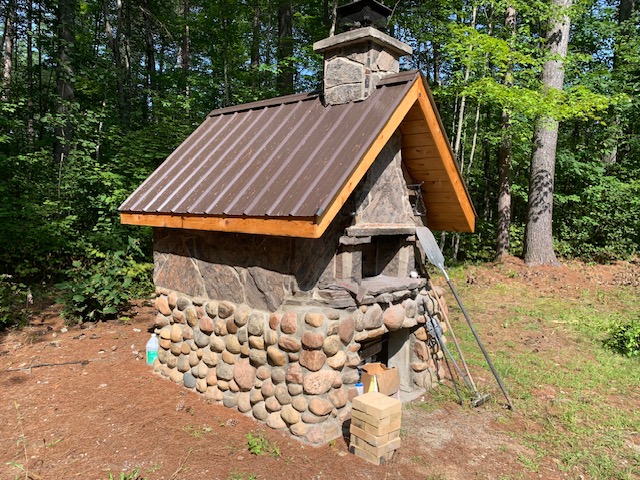

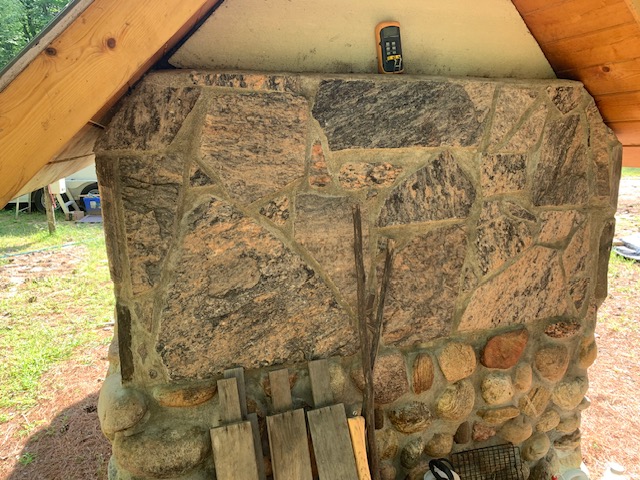

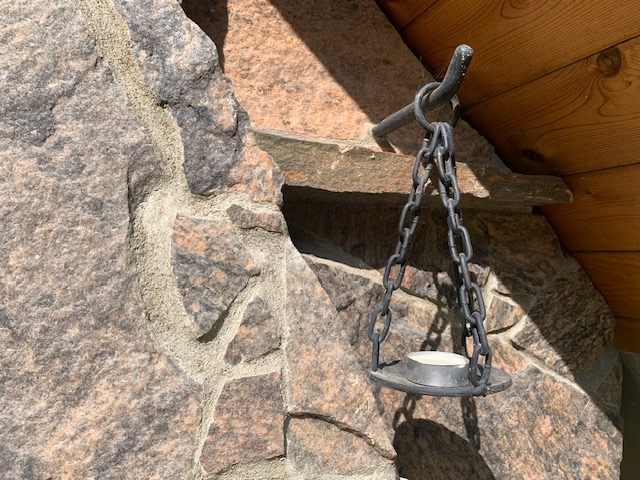
Here are a few pics of my mostly completed oven. I still have to build a black steel door for the bottom front and the top rear section. But the brick and stone work is done.
Dean
That's a beauty! Have you had a chance to bake with it yet?
Paul
Hi Paul,
Thank you! Yes it has been functional since about 6 months into the build. It just took a while to make it look pretty. :)
The heat retention is pretty amazing. Pizza in the evening, then bread the next morning. The next two or three days after that it can be used for cooking stews, etc. After about 5 days when it drops to under 200F I load the wood for the next fire and leave the door cracked open, and let it kiln dry so it ignites easily when I refire it. I also use it to make Montreal bagels.
Dean
Oh, I'll be looking forward to the new photos! Good luck to you!